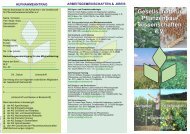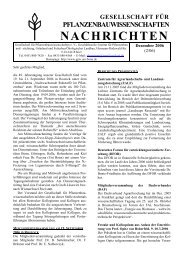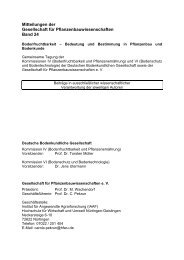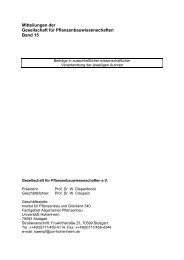Mitteilungen der Gesellschaft für Pflanzenbauwissenschaften Band 23
Mitteilungen der Gesellschaft für Pflanzenbauwissenschaften Band 23
Mitteilungen der Gesellschaft für Pflanzenbauwissenschaften Band 23
Sie wollen auch ein ePaper? Erhöhen Sie die Reichweite Ihrer Titel.
YUMPU macht aus Druck-PDFs automatisch weboptimierte ePaper, die Google liebt.
Mitt. Ges. Pflanzenbauwiss. <strong>23</strong>: 182 (2011)<br />
Spatio-temporal patterns of phenological development in Germany<br />
in relation to temperature and day length<br />
Stefan Siebert and Frank Ewert<br />
Institute of Crop Science and Resource Conservation, University of Bonn. E-Mail: s.siebert@unibonn.de<br />
Introduction<br />
Phenological development of crops has been extensively studied in field experiments<br />
but less at larger scales for which data availability is often limited. To which extent<br />
the spatio-temporal variability of crop development can be explained by relationships<br />
<strong>der</strong>ived from field studies as the temperature sum concept (e.g. McMaster et al.,<br />
2008; Ewert et al., 1999), used in many crop models is unclear but would support the<br />
large scale application of these models. The aim of this study was to analyze the<br />
spatio-temporal patterns of crop phenological development in response to<br />
temperature and day length.<br />
Material and Methods<br />
We used a comprehensive data set (656<strong>23</strong>4 phenological observations at 6019<br />
observation sites) about the phenology of oat (Avena sativa L.) and related climate<br />
data from Germany for the period 1959 to 2009.<br />
Results and Discussion<br />
Our results show that the statistically significant warming trend since 1959 resulted in<br />
an earlier onset of all phenological stages and a shortening of most phenological<br />
phases with a 17 days earlier onset of yellow ripeness and a shortening of the phase<br />
sowing to yellow ripeness by 14 days. There was also a distinct spatial pattern in<br />
phenological development with differences among eco-regions in the occurrence of<br />
development stages of 15-26 days depending on the stage and the length of the<br />
phases between stages of 6-21 days depending on the phase. Most of this spatiotemporal<br />
variability could be explained through the effect of temperature and day<br />
length. However, temperature sums (thermal times) and day length corrected<br />
temperature sums (photothermal times) also varied in time and space pointing to the<br />
use of different varieties over time and across eco-regions. The good agreement of<br />
the thermal and photothermal requirements of oat computed in this study with<br />
relationships known from field experiments supports the use of the temperature sum<br />
concept for large scale application to simulate crop phenology in response to<br />
temperature and day length.<br />
References<br />
Ewert, F., van Oijen, M., Porter J.R 1999: Simulation of growth and development processes of spring<br />
wheat in response to CO2 and ozone for different sites and years in Europe using mechanistic crop<br />
simulation models. European Journal of Agronomy 10:<strong>23</strong>1-247.<br />
McMaster, G.S., White, J.W., Hunt, L.A., Jamieson, P.D., Dhillon, S.S., Ortiz-Monasterio, J.I. 2008:<br />
Simulating the influence of vernalization, photoperiod and optimum temperature on wheat<br />
developmental rates. Annals of Botany 102:561-569.







